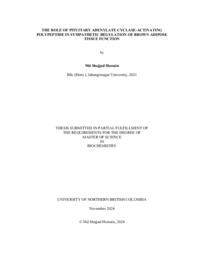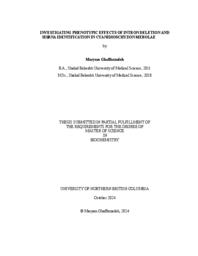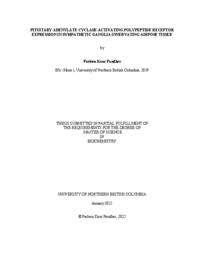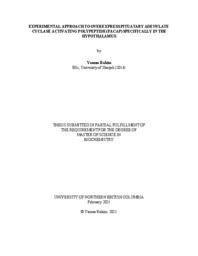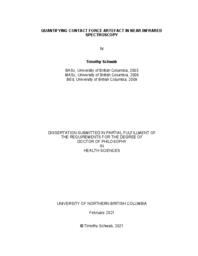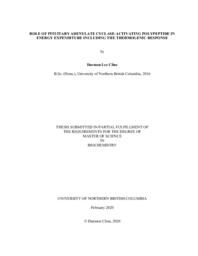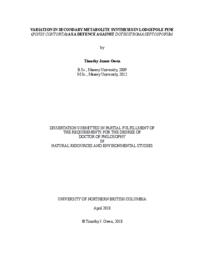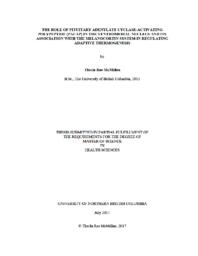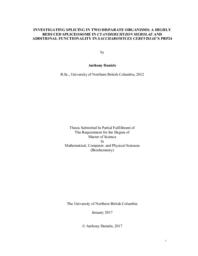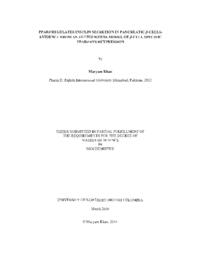Gray, Sarah
Person Preferred Name
Sarah Gray
Related Works
Content type
Digital Document
Origin Information
Content type
Digital Document
Origin Information
Content type
Digital Document
Description / Synopsis
Obesity harms the health and quality of life of millions of people worldwide and places financial stress on patients and healthcare systems. The metabolic breakdown and development of disease, such as type 2 diabetes, that occurs with obesity has been shown to be largely driven by adipose tissue dysfunction resulting from adipose tissue hypoxia, adipocyte death, macrophage infiltration, and fibrosis. The early stage of adipose tissue fibrosis is poorly understood, particularly in female mice. To identify the initiating molecular changes in adipose tissue fibrosis we have measured the expression of a suite of molecular targets crucial to the development of adipose tissue inflammation and fibrosis in obesity including tumor necrosis factor-alpha (TNF-α; early inflammatory and insulin resistance driver), transforming growth factor-beta (TGF-β; pro-fibrotic cytokine), collagen VI (abundant in fibrotic lesions), matrix metalloproteinase-14 (MMP-14; key extracellular matrix protease in adipose tissue), and tissue inhibitors of MMPs 1-4 (TIMPs 1-4; modulators of proteolytic activity). The first part of this work details the development of a murine model of diet-induced obesity, early insulin resistance, and adipose tissue fibrosis without diagnosable fibrotic build-up quantified with picrosirius red. The second part of this work shows early changes in the expression of key inflammatory and fibrotic components in adipose tissue, including mRNA upregulation of TNF-α, TGF-β, and collagen VI in both sexes, as well as upregulation of TIMP-1 in male mice and TIMP-4 in female mice. Collagen VI immunoreactivity in visceral adipose tissue is also increased, but only in males. These molecular changes are conducive to the development of a fibrotic milieu and represent the initiating steps in adipose tissue fibrosis. This work has improved our understanding of the molecular processes in obesity development and highlights potential targets for therapeutic intervention in the treatment of obesity and metabolic disease.
Origin Information
Content type
Digital Document
Description / Synopsis
The strategic allocation of resources to maximize fitness is the organizing principle shaping the evolution of life histories. The physiology and behaviour of animals is a manifestation of trade-offs in resource allocation among traits and activities that benefit current or future reproduction. In theory, traits subject to such trade-offs are expected to show negative correlations, but numerous field studies have documented apparent contradictions to theoretical expectations: in some populations, parental effort (allocation to current reproduction) and reproductive performance (i.e., a fitness component) are not negatively correlated to self-maintenance (allocation to future reproduction). One explanation for such findings is that inter-individual variation in resource acquisition can obscure trade-offs by altering the overall quantity of resources individuals are able to invest. Acquisition may influence both the quantity of resources allocated in trade-offs as well as reproductive success. Asymmetries in acquisition may be the product of differences in intrinsic quality (individual phenotypes) and/or environmental factors (territory quality). In a population of breeding mountain bluebirds (Sialia currucoides), I sought to determine how resource acquisition varied, and to identify how it may affect life-history trade-offs and reproductive performance. In my research, I used several lines of inquiry to characterize how resource acquisition varies and affects trade-offs in the study population. First, I showed that offspring quality, a contributor to fitness, is influenced by the types of prey nestling bluebirds are fed by their parents, and that the resources parents provide to their broods vary seasonally and as their nestlings age. Next, I used a short-term manipulation of brood age to find that parents have limited flexibility in their capacity to acquire resources while provisioning broods, which may be due to intrinsic or extrinsic constraints. I then identified relationships among the landscape characteristics of breeding territories (extrinsic factors, potentially influencing acquisition) and the reproductive performance of bluebirds, over an 11-year period. These characteristics, elevation and distance to forest edges, are subsequently linked to differences in microclimate, microhabitat, and parental prey use, providing a partial explanation for why occupancy and reproductive success are spatially clustered and consistent over time. Finally, I used a brood size manipulation to induce changes in parental effort, revealing that acquisition (quantified as both individual and territory quality) influences how mountain bluebirds trade-off one proxy for self-maintenance (energy metabolites) with providing food to their offspring. Interestingly, these effects differed between the sexes. Females generally biased allocation towards current reproduction, increasing provisioning to larger broods, regardless of territory quality; females on low-quality territories subsidized increased provisioning activity by catabolizing stored resources. In contrast, only males on high-quality territories increased parental effort in response to larger broods, and among these individuals, only high-quality males incurred an energy deficit to subsidize this activity. My findings showed that resource acquisition may be critical to understanding why trade-offs differ among individuals, and that both intrinsic and extrinsic limits on acquisition may influence the patterns of allocation we observe in wild populations.
Origin Information
Content type
Digital Document
Description / Synopsis
Obesity is a disease that occurs when energy intake exceeds energy expenditure, concomitantly increasing risk of chronic diseases, including metabolic diseases such as diabetes. Research into therapeutics to correct dysregulations in energy balance is on the rise, and one notable neuropeptide being studied is pituitary adenylate cyclase-activating polypeptide (PACAP). PACAP has been shown to regulate thermogenesis, an energy burning process regulated by the sympathetic nervous system (SNS) in response to cold stress and overfeeding, but its role within the sympathetic nerves innervating and regulating energy metabolism in adipose tissues is not well understood. We hypothesize that PACAP is acting on PACAP receptors (PAC1, VPAC1, VPAC2) expressed in stellate ganglia innervating brown adipose tissue, the main thermogenic organ in mammals. We have established a reliable protocol for the isolation of two ganglia of the SNS (stellate and superior cervical) and provided recommendations of reference genes to use as internal controls for gene expression studies. For the first time, we confirmed PACAP receptor gene expression in the stellate ganglia, and saw sex-specific, differential gene expression based on housing temperature. We subsequently analyzed the expression of PAC1 splice variants in the stellate ganglia and our positive control tissues (adrenal gland and superior cervical ganglia), identifying at least two variants in these SNS tissues. This work adds to current literature on the study of thermogenesis and energy balance, and encourages future work characterizing G-protein coupled receptors (GPCRs) for their therapeutic application, enhancing our fundamental understanding of autonomic physiology in mammals.
Origin Information
Content type
Digital Document
Description / Synopsis
Obesity is adetrimental health condition that occurs when energy intake, exceeds energy expenditure. Pituitary adenylatecyclase-activating polypeptide (PACAP) regulates energy expenditure, including adaptive thermogenesis, through the hypothalamic-sympatheticnervous system-brown adipose tissue axis. We hypothesize that PACAP expression in the ventromedial nucleus (VMN) is required for adaptive thermogenesis. To assess this, our goal is to develop an animal model that expresses PACAP specifically in the VMN of the hypothalamus. As a first step to achieving this goal, we established a protocol to deliver an adeno-associatedvirus (AAV) expressing the visible protein eGFP under the control of a VMN-specific promoter, steroidogenic factor 1 (SF1) using stereotaxic surgery. A second step was to develop a protocol to detect PACAP mRNA in the brain using in situ hybridization. Our results showed that the stereotaxic protocol was successful and provides significant progress towards achieving PACAP-specific expression in the VMN.
Origin Information
Content type
Digital Document
Description / Synopsis
Transcutaneous near infrared spectroscopy (NIRS) of muscle requires coupling between the device and the skin. An unfortunate by-product of this coupling is contact force artefact, where the amount of contact force between the device and the skin affects measurements. Contact force artefact is well known, but largely ignored in most NIRS research. We performed preliminary investigations of contact force artefact to quantify tissue behaviour to inform future NIRS designs. Specifically, we conducted three studies on contact force artefact: (i) an experimental investigation of static load at varied levels of contact force and muscle activation, (ii) an experimental investigation of oscillating load at varied levels of contact force and frequency, and (iii) a Monte Carlo simulation of photon propagation through skin, adipose tissue, and muscle. Our results confirmed that contact force artefact is a confounding factor in NIRS muscle measurements because contact force affects measured hemoglobin concentrations in a manner consistent with muscle contractions. Further, the effects of contact force are not altered by muscle contraction and a likely candidate for the mechanism responsible for contact force artefact is the viscoelastic compression of superficial tissues (skin and adipose) during loading. Simulation data suggests that adipose tissue plays a key role in diffuse reflectance of photons, so any compression of the superficial tissues will affect the reflected signal. Further research is required to fully understand the mechanisms behind contact force artefact, which will, in turn, inform future NIRS device designs.
Origin Information
Content type
Digital Document
Description / Synopsis
Understanding the mountain pine beetle detoxification systems is vital for predicting its continued spread into the novel jack pine host. Phylogenetic analyses were conducted for mountain pine beetle catalase, glutathione peroxidase, superoxide dismutase, and peroxiredoxin. These proteins were generally conserved, but there were differences in some key functional motifs. Specifically, a peroxiredoxin (DPPrx1) contained a unique combination of hyperoxidation motifs. DPPrx1 and a superoxide dismutase (DPSOD1) were selected for further functional analyses and demonstrated higher reactivity when compared to other SOD and Prx proteins. Also, DPPrx1 experiences hyperoxidation at a lower H2O2 concentration (~0.06 mM) than human peroxiredoxin (~0.12 mM). In other systems, hyperoxidized peroxiredoxin does act as a signal molecule for the expression of other oxidative stress proteins. Therefore, due to its relatively high reactivity and potential role as a cellular signal, DPPrx1 could serve as a future pest management target.
Origin Information
Content type
Digital Document
Description / Synopsis
Obesity results when energy intake chronically exceeds energy expenditure, driving accumulation and malfunctioning of white adipose tissue and increasing risk for comorbidity. Brown adipose tissue (BAT) burns energy via adaptive thermogenesis, a process gaining therapeutic interest to restore energy balance in obesity. PACAP regulates energy expenditure including thermogenesis in BAT, but the neuronal circuits involved are not well known. Thus, we aim to develop a tool to safely restore PACAP in the hypothalamic ventromedial nucleus (VMN) of PACAP-null mice to assess the VMN’s contribution. We also investigated whether PACAP directly regulates BAT function by binding at adipocytes. We discovered PACAP receptor expression in BAT and genetic regulation of receptor expression with cold acclimation. Acute in vitro studies did not show PACAP-stimulated thermogenesis in BAT. Studying adaptive thermogenesis and its hypothalamic regulation will contribute to the field of energy metabolism, and the pathophysiology of obesity and type 2 diabetes.
Origin Information
Content type
Digital Document
Origin Information
Content type
Digital Document
Origin Information
Content type
Digital Document
Origin Information
Content type
Digital Document
Origin Information
Content type
Digital Document
Origin Information
Content type
Digital Document
Origin Information

